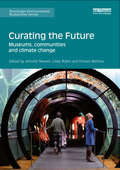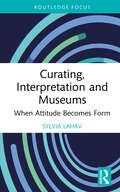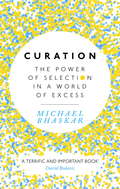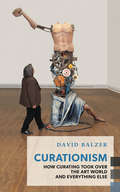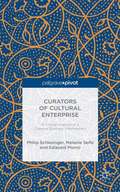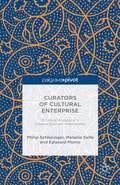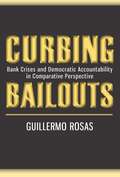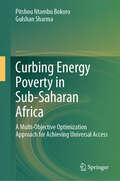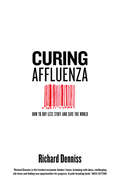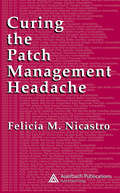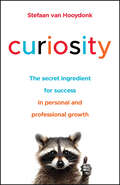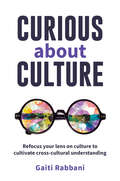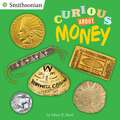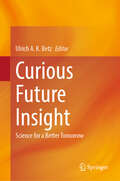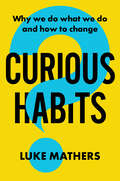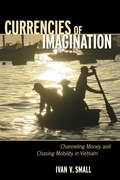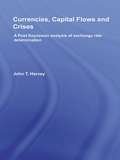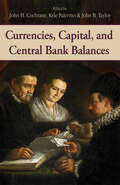- Table View
- List View
Curating the Future: Museums, Communities and Climate Change (Routledge Environmental Humanities)
by Libby Robin Jennifer Newell Kirsten WehnerCurating the Future: Museums, Communities and Climate Change explores the way museums tackle the broad global issue of climate change. It explores the power of real objects and collections to stir hearts and minds, to engage communities affected by change. Museums work through exhibitions, events, and specific collection projects to reach different communities in different ways. The book emphasises the moral responsibilities of museums to address climate change, not just by communicating science but also by enabling people already affected by changes to find their own ways of living with global warming. There are museums of natural history, of art and of social history. The focus of this book is the museum communities, like those in the Pacific, who have to find new ways to express their culture in a new place. The book considers how collections in museums might help future generations stay in touch with their culture, even where they have left their place. It asks what should the people of the present be collecting for museums in a climate-changed future? The book is rich with practical museum experience and detailed projects, as well as critical and philosophical analyses about where a museum can intervene to speak to this great conundrum of our times. Curating the Future is essential reading for all those working in museums and grappling with how to talk about climate change. It also has academic applications in courses of museology and museum studies, cultural studies, heritage studies, digital humanities, design, anthropology, and environmental humanities.
Curating the Future: Museums, Communities and Climate Change (Routledge Environmental Humanities)
by Libby Robin Jennifer Newell Kirsten WehnerCurating the Future: Museums, Communities and Climate Change explores the way museums tackle the broad global issue of climate change. It explores the power of real objects and collections to stir hearts and minds, to engage communities affected by change. Museums work through exhibitions, events, and specific collection projects to reach different communities in different ways. The book emphasises the moral responsibilities of museums to address climate change, not just by communicating science but also by enabling people already affected by changes to find their own ways of living with global warming. There are museums of natural history, of art and of social history. The focus of this book is the museum communities, like those in the Pacific, who have to find new ways to express their culture in a new place. The book considers how collections in museums might help future generations stay in touch with their culture, even where they have left their place. It asks what should the people of the present be collecting for museums in a climate-changed future? The book is rich with practical museum experience and detailed projects, as well as critical and philosophical analyses about where a museum can intervene to speak to this great conundrum of our times. Curating the Future is essential reading for all those working in museums and grappling with how to talk about climate change. It also has academic applications in courses of museology and museum studies, cultural studies, heritage studies, digital humanities, design, anthropology, and environmental humanities.
Curating, Interpretation and Museums: When Attitude Becomes Form (Routledge Focus on the Global Creative Economy)
by Sylvia LahavFollowing a period of strategic and ideological change in museums, this book outlines new attitudes in curating and display, education and learning, text and interpretation, access, inclusion, participation, space, and the issues around the sustainability of the encyclopaedic collection. Focused on the contemporary period, the author questions the extent to which the museum visitor has become reliant on interpretative text and examines the development of new museum spaces where visitor interaction and engagement is welcomed. Changes of attitude have transformed our museums into modern spaces that reflect current needs and modern expectations and yet our permanent collections remain relatively unchanged, sometimes an uncomfortable reminder of a time when values, ethics, and attitudes were very different. The author will discuss these conflicts of ideology. Written by a researcher with expertise in museum practice, this shortform book offers a new approach that will be valuable reading for students and scholars of cultural management and policy, as well as providing insights for reflective museum practitioners.
Curation: The power of selection in a world of excess
by Michael Bhaskar'A terrific and important book . . . it's a great, fresh take on how the 21st century is transforming the way we select everything from food to music' David Bodanis, author of E=MC2In the past two years humanity has produced more data than the rest of human history combined. We carry a library of data in our pockets, accessible at any second. We have more information and more goods at our disposal than we know what to do with. There is no longer any competitive advantage in creating more information. Today, value lies in curation: selecting, finding and cutting down to show what really matters.Curation reveals how a little-used word from the world of museums became a crucial and at times controversial strategy for the twenty-first century. Today's most successful companies - Apple, Netflix, Amazon - have used curation to power their growth, by offering customers more tailored and appropriate choices.Curation answers the question of how we can live and prosper in an age of information overload. In the context of excess, it is not only a sound business strategy, but a way to make sense of the world.
Curationism: How Curating Took Over the Art World and Everything Else (Exploded Views)
by David Balzer"Now that we 'curate' even lunch, what happens to the role of the connoisseur in contemporary culture?'Curate' is now a buzzword applied to everything from music festivals to artisanal cheese. Inside the art world, the curator reigns supreme, acting as the face of high-profile group shows and biennials in a way that can eclipse and assimilate the contributions of individual artists. At the same time, curatorial studies programs continue to grow in popularity, and businesses are increasingly adopting curation as a means of adding value to content and courting demographics. Everyone, it seems, is a now a curator. But what is a curator, exactly? And what does the explosive popularity of curating say about our culture's relationship with taste, labour and the avant-garde?In this incisive and original study, critic David Balzer travels through art history and around the globe to explore the cult of curation - where it began, how it came to dominate museums and galleries, and how it was co-opted at the turn of the millennium as the dominant mode of organizing and giving value to content. At the centre of the book is a paradox: curation is institutionalized and expertise-driven like never before, yet the first independent curators were not formally trained, and any act of choosing has become 'curating.' Is the professional curator an oxymoron? Has curation reached a sort of endgame, where its widespread fetishization has led to its own demise?David Balzer has contributed to publications including the Believer, Modern Painters, Artforum.com, and The Globe and Mail, and is the author of Contrivances, a short-fiction collection. He is currently Associate Editor at Canadian Art magazine. Balzer was born in Winnipeg and currently resides in Toronto, where he makes a living as a critic, editor and teacher.
Curators Of Cultural Enterprise: A Critical Analysis Of A Creative Business Intermediary
by Philip Schlesinger Melanie Selfe Ealasaid MunroThis study is based on the authors' fieldwork inside Cultural Enterprise Office, a small Scottish agency that supports creative businesses. It discusses UK policy on the creative economy, the rise of intermediaries between policy-making and the marketplace, and the playing out in the delivery of business advice services to creative microbusinesses.
Curators of Cultural Enterprise: A Critical Analysis of a Creative Business Intermediary
by Philip Schlesinger Melanie Selfe Ealasaid MunroThis study is based on the authors' fieldwork inside Cultural Enterprise Office, a small Scottish agency that supports creative businesses. It discusses UK policy on the creative economy, the rise of intermediaries between policy-making and the marketplace, and the playing out in the delivery of business advice services to creative microbusinesses.
Curbing Bailouts
by Guillermo Rosas"Rosas's compelling theory and wide-ranging empirical evidence yield a persuasive but surprising conclusion in light of the financial meltdown of 2008-9. In the event of banking crises, not only do elected governments treat taxpayers better and force bankers and their creditors to pay more for their mistakes, but bankers in democracies are more prudent as a consequence . . . essential reading for all interested in the political economy of crisis and in the future of banking regulation. " ---Philip Keefer, Lead Economist, Development Research Group, The World Bank "Rosas convincingly demonstrates how democratic accountability affects the incidence and resolution of banking crises. Combining formal models, case studies, and cutting-edge quantitative methods, Rosas's book represents a model for political economy research. " ---William Bernhard, Professor, Department of Political Science, University of Illinois "When the financial crises of the 1990s hit Asia, Russia, and Latin America, the U. S. scolded them about the moral hazard problems of bailing out the banks. Now, the shoe is on the other foot, with the U. S. struggling to manage an imploding financial sector. Rosas's study of bank bailouts could not be more timely, providing us with both a framework for thinking about the issue and some sobering history of how things go both right and badly wrong. Democratic accountability proves the crucial factor in making sure bailouts are fair, a point that is as relevant for U. S. policy as for an understanding of the emerging markets. " ---Stephan Haggard, Krause Professor, Graduate School of International Relations and Pacific Studies, University of California, San Diego Banking crises threaten the stability and growth of economies around the world. In response, politicians restore banks to solvency by redistributing losses from bank shareholders and depositors to taxpayers, and the burden the citizenry must bear varies from case to case. Whereas some governments stay close to the prescriptions espoused by Sir Walter Bagehot in the nineteenth century that limit the costs shouldered by taxpayers, others engage in generous bank bailouts at great cost to society. What factors determine a government's response? In this comparative analysis of late-twentieth-century banking crises, Guillermo Rosas identifies political regime type as the determining factor. During a crisis, powerful financial players demand protection of their assets. Rosas maintains that in authoritarian regimes, government officials have little to shield them from such demands and little incentive for rebuffing them, while in democratic regimes, elected officials must weigh these demands against the interests of the voters---that is, the taxpayers. As a result, compared with authoritarian regimes, democratic regimes show a lower propensity toward dramatic, costly bailouts. Guillermo Rosas is Assistant Professor in the Department of Political Science and Fellow at the Center in Political Economy at Washington University in St. Louis.
Curbing Energy Poverty in Sub-Saharan Africa: A Multi-Objective Optimization Approach for Achieving Universal Access
by Pitshou Ntambu Bokoro Gulshan SharmaThis book emphasizes the critical need for a multi-dimensional approach to tackling energy poverty, advocating for an integrated strategy that addresses three interconnected dimensions: availability, accessibility, and affordability. It introduces a robust Multi-Criteria Decision-Making (MCDM) framework based on a dynamic model that links off-grid energy supply to rural households primarily engaged in crop farming as a key economic activity. The framework leverages the Non-Dominated Sorting Genetic Algorithm II (NDSGA-II), a powerful multi-objective optimization technique, to balance the trade-offs between costs and revenues, ensuring the sustainable delivery of energy services to rural communities. By underscoring the interplay between availability, accessibility, and affordability, the approach reveals that while costs are primarily associated with securing energy availability, revenues are essential for enhancing both accessibility and affordability. This comprehensive and holistic strategy offers an innovative solution to the multifaceted challenges of energy poverty in rural areas, ensuring long-term sustainability and economic viability.
Curbing the Urge to Merge
by Jeffrey PfefferWhen companies face competitive challenges and business difficulties, many turn to financial engineering solutions like mergers instead of directly addressing and fixing fundamental operational problems. This chapter examines why companies so often opt for the merger solution, in spite of evidence that indicates failure as a common outcome.
Curing Affluenza: How to Buy Less Stuff and Save the World
by Richard DennissAffluenza has not just changed the world, it has also changed the way we see the world. Short of money? Borrow some. Caught in the rain? Buy an umbrella. Thirsty? Buy a bottle of water and throw the bottle away. Our embrace of “convenience” and our acceptance of our inability to plan ahead is an entirely new way of thinking, and over the past seventy years we have built a new and different economic system to accommodate it. There is nothing inevitable about this current way of thinking, consuming, and producing. On the contrary, the vast majority of humans who have ever lived would find the idea of using our scarce resources to produce things that are designed to be thrown away absolutely senseless. The fact that our consumer culture is a recent innovation does not mean it will be easy to change. Indeed, the last few decades have shown how contagious affluenza can be. But we have not always lived this way, which proves that we don’t have to persist with it. We can change—if we want to.
Curing the Patch Management Headache
by Felicia M. WetterA comprehensive security patch management process is one of the fundamental security requirements for any IT-dependent organization. Fully defining this process ensures that patches are deployed in an organized, staged manner, resulting in little or no slowdowns or downtime to network infrastructure. Until now, there were no technical books for com
Curiosity: The Secret Ingredient for Success in Personal and Professional Growth
by Stefaan van HooydonkUnleash your inner curiosity to experience a new world of meaning and opportunity Curiosity: The Secret Ingredient for Success in Personal and Professional Growth describes the ins and outs of curiosity: what it is, how it works and what it does; how it influences success for individuals and organisations, why it is hard to maintain over time and how we – and our organisations - can get (even) better at it. The book is a practical guide for professionals to help them become aware of and take intentional action towards being more curious towards the world, others and even themselves. With curiosity gaining traction in the business world as a new paradigm for being, relating and leading for the 21st century, Stefaan van Hooydonk’s deep dive into the very concept of curiosity has never been more timely. In this book, readers will learn about: ● Why curiosity is magical and complex—and far more than a simple one-dimensional word ● How curiosity drives innovation, continuous improvement, and employee engagement all at once ● The science of curiosity, drawing on insights from data and the latest research on this topic A highly unique resource on one of the most influential concepts in business success and beyond, Curiosity earns a well-deserved spot on the bookshelves of professionals young and old, as well as HR, learning professionals, managers, and all individuals seeking to be a little more curious and unlock a new world of meaning and opportunity.
Curious About Culture: Refocus your lens on culture to cultivate cross cultural understanding
by Gaiti RabbaniWhether you are on a journey of self-reflection or wish to influence others, this definitive guide to cross-cultural engagement will help you to understand your own cultural narrative and better connect with people of other cultural backgrounds.Curious about Culture by Gaiti Rabbani invites readers on a journey of introspection to discover the multitude of cultural influences that shape their view of the world.Culture is not geographically bound. It is about more than just where you were born and where you live. Gender, generation and language, among other factors, all contribute to your cultural lens and how well you can connect with others.Improving cross-cultural engagement starts with understanding yourself. You will uncover your own cultural drivers that will help you cultivate meaningful cross-cultural conversations. We all have multiple facets to our identities and some of them are likely to be stigmatised. The author encourages readers to be curious and dive beyond the apparent cues when engaging across cultures, highlighting the pitfalls of drawing upon assumptions and defaulting to stereotypes.Anecdotes from the leading cultural intelligence specialist, Gaiti Rabbani's rich personal and professional experiences along with research-based insights, create a relatable, insightful and thought-provoking read. Whether you are on a journey of self-reflection or wish to influence others, this book will help you to understand your own cultural narrative and better connect with people of other cultural backgrounds.Curious about Culture is a practical reference for the enterprising and curious professional.
Curious About Money (Smithsonian)
by Mary E. ReidMoney talks . . . about history!Shells. Coins. Paper bills. Credit cards. Bitcoins. People have used all kinds of objects to buy, sell, or trade. Aren&’t you curious: what is money? Developed with numismatic curators at the Smithsonian, this fascinating book looks at how people, money, and history intersect, right on up to what's current about currency.Penguin-Smithsonian nonfiction: where content meets cool!
Curious Future Insight: Science for a Better Tomorrow
by Ulrich A. K. BetzThis book follows up the debate on the future of science and technology at the Curious2022 – Future Insight Conference, the second event in this conference series initiated on the occasion of Merck’s 350th anniversary. In the chapters, some of the world’s top scientists, managers and entrepreneurs explore breakthrough technologies and how they can be applied to make a better world for humanity. The book begins with an introduction to the vision of the conference “United by science for a better tomorrow” and the impacts caused by the pandemic, highlighting the importance of gathering like-minded people to discuss and support the advancement of science and technology for the benefit of humanity. In the first part of the book, readers will also find a chapter written by the Executive Board of Merck KGaA discussing the importance of curiosity for innovation and an overview of the company’s contribution in the areas of life sciences, healthcare and electronics forward-moving the scientific discovery. The second part of the book offers insights of some of the scientific topics discussed at the conference, and particular attention is given to new therapies and sustainability. In the final part of the book, readers will find some thoughts on ethical principles guiding our application of science and technology to create a bright future for humanity, and diverse perspectives on topics such as health, life sciences, nutrition, material sciences, digitalization, AI, energy, mobility, space flight, robotics, the secrets of the human mind and new ways of working together. Given its interdisciplinary appeal, the book will inspire curiosity in a wide readership, from scholars and researchers to professionals with an interest in exploring the future of science and technology, solving the problems of today, and paving the way for a better tomorrow. Chapters 1 and 2 are available open access under a Creative Commons Attribution 4.0 International License via link.springer.com
Curious Habits: Why we do what we do and how to change
by Luke MathersA curious habit is helpful... until it's not.Attention to detail is great – perfectionism is a curious habit.Chocolate is awesome – using it to treat anxiety is a curious habit.Honest self-awareness is admirable – constantly beating yourself up is a curious habit.We have habits for a reason, we repeat things that feel good and move away from the stuff we don't like. Our habits solve a problem and make life easier. Unfortunately, our habits can turn on us. This book teaches us how to use curiosity as a superpower. It takes the blame and shame out of habit change so that we make the change not because we HAVE to, but because we WANT to.Drawing from the collective wisdom of evolutionary biology, neuroscience, Stoic philosophy and even Instagram, leading mindset coach Luke Mathers helps us embrace the power of curiosity to recognise when habits start to impact negatively our health and happiness. Curious Habits offers an entertaining, thought-provoking and non-judgmental exploration into why we do the things we do, and how to reset for a healthier, happier and more fulfilling life.
Curled Metal Inc.--Engineered Products Division
by Frank V. Cespedes Benson P. ShapiroCurled Metal Incorporated has declining sales, but has developed a new product (curled metal pile driver pads) that, in field tests, deliver customer benefits that are many times CMI's manufacturing costs. Joseph Fernandez and Rajiv Sanwal of CMI's Engineered Products Division are responsible for formulating a strategy for the new product. A key issue is the price to charge for the pads. The case raises issues of analyzing market potential, aligning price with business strategy, and the implications of a price on development and execution of integrated strategic options.
Currencies of Imagination: Channeling Money and Chasing Mobility in Vietnam
by Ivan V. SmallIn Vietnam, international remittances from the Vietnamese diaspora are quantitatively significant and contribute important economic inputs. Yet beyond capital transfer, these diasporic remittance economies offer insight into an unfolding transformation of Vietnamese society through the extension of imaginations and ontological possibilities that accompany them. Currencies of Imagination examines the complex role of remittances as money and as gifts that flow across, and mediate between, transnational kinship networks dispersed by exile and migration.Long distance international gift exchanges and channels in a neoliberal political economy juxtapose the increasing cross-border mobility of remittance financial flows against the relative confines of state bounded bodies. In this contradiction Ivan V. Small reveals a creative space for emergent imaginaries that disrupt local structures and scales of desire, labor and expectation. Furthermore, the particular characteristics of remittance channels and mediums in a global economy, including transnational mobility and exchangeable value, affect and reflect the relations, aspirations, and orientations of the exchange participants. Small traces a genealogy of how this phenomenon has shifted through changing remittance forms and transfer infrastructures, from material and black market to formal bank and money services. Transformations in the affective and institutional relations among givers, receivers, and remittance facilitators accompany each of these shifts, illustrating that the socio-cultural work of remittances extends far beyond the formal economic realm they are usually consigned to.
Currencies, Capital Flows and Crises: A Post Keynesian Analysis of Exchange Rate Determination (Routledge Advances In Heterodox Economics Ser. #2)
by John T. HarveyBreaking from conventional wisdom, this book provides an explanation of exchange rates based on the premise that it is financial capital flows and not international trade that represents the driving force behind currency movements. John T. Harvey combines analyses rooted in the scholarly traditions of John Maynard Keynes and Thorstein Veblen with that of modern psychology to produce a set of new theories to explain international monetary economics, including not only exchange rates but also world financial crises. In the book, the traditional approach is reviewed and critiqued and the alternative is then built by studying the psychology of the market and balance of payments questions. The central model has at its core Keynes’ analysis of the macroeconomy and it assumes neither full employment nor balanced trade over the short or long run. Market participants’ mental model, which they use to forecast future exchange rate movements, is specified and integrated into the explanation. A separate but related discussion of currency crises shows that three distinct tension points emerge in booming economies, any one of which can break and signal the collapse. Each of the models is compared to post-Bretton Woods history and the reader is shown exactly how various shifts and adjustments on the graphs can explain the dollar’s ups and downs and the Mexican (1994) and Asian (1987) crises.
Currencies, Capital, and Central Bank Balances
by John H. Cochrane, PhD; Kyle Palermo; John B. TaylorDrawing from their 2018 conference, the Hoover Institution brings together leading academics and monetary policy makers to share ideas about the practical issues facing central banks today. The expert contributors discuss U.S. monetary policy at individual central banks and reform of the international monetary and financial system. The discussion is broken down into seven key areas: 1) International Rules of the Monetary Game; 2) Banking, Trade and the Making of the Dominant Currency; 3) Capital Flows, the IMF's Institutional View and Alternatives; 4) Payments, Credit and Asset Prices; 5) Financial Stability, Regulations and the Balance Sheet; 6) The Future of the Central Bank Balance Sheet; and 7) Monetary Policy and Reform in Practice. With in-depth discussions of the volatility of capital flows and exchange rates, and the use of balance sheet policy by central banks, they examine relevant research developments and debate policy options.
Currencies, Commodities and Consumption
by Kenneth W. ClementsCurrency values, prices, consumption and incomes are at the heart of the economic performance of all countries. In order to make a meaningful comparison between one economy and another, economists routinely make use of purchasing power parity (PPP) exchange rates, but while PPP rates are widely used and well understood, they take a lot of effort to produce and suffer from publication delays. Currencies, Commodities and Consumption analyses the strengths and weaknesses of two alternatives to PPP. Firstly, the so-called Big Mac Index, which uses hamburger prices as a standard of measurement, and second, a less well known technique which infers incomes across countries based on the proportion of consumption devoted to food. Kenneth W. Clements uses international macroeconomics, microeconomic theory and econometrics to provide researchers and policy makers with insights into alternatives to PPP rates and make sense of the ongoing instability of exchange rates and commodity prices.
Currency Board Arrangements Issues and Experiences
by Charles Enoch Toms J. T. BalioA report from the International Monetary Fund.
Currency Conflict and Trade Policy: A New Strategy for the United States
by C. Fred Bergsten Joseph GagnonConflicts over currency valuations are a recurrent feature of the modern global economy. To strengthen their international competitiveness, many countries resort to buying foreign currencies to make their exports cheaper and their imports more expensive. In the first decade of the twenty-first century, for example, China's currency manipulation practices were so flagrant that they produced a backlash in the United States and other trading partners, prompting threats of retaliation. How damaging is the practice of currency manipulation—and how extensive is the problem? This book by C. Fred Bergsten and Joseph E. Gagnon—two leading experts on trade, investment, and the effects of currency manipulation—traces the history, causes, and effects of currency manipulation and analyzes a range of policy responses that the United States could adopt. The book is an indispensable guide to a complex and serious problem and what might be done to solve it.
Currency Convertibility and the Transformation of Centrally Planned Economies
by Peter Isard Joshua E. GreeneThis paper examines the problems in establishing currency convertibility- and the optimal timing- in formerly planned economies making the transition to market-oriented systems.
